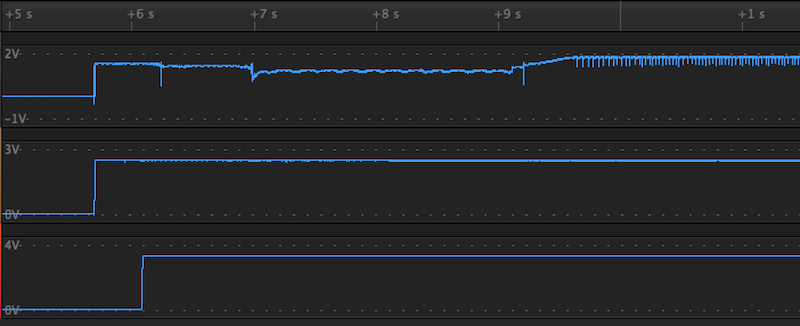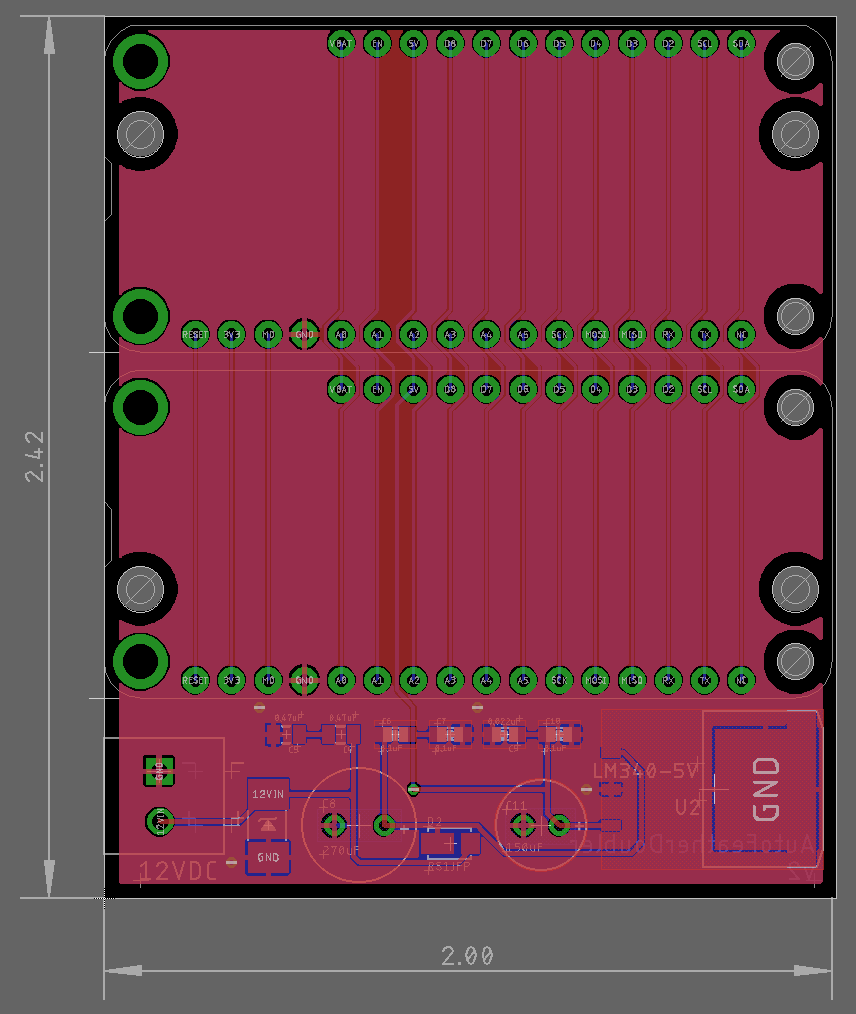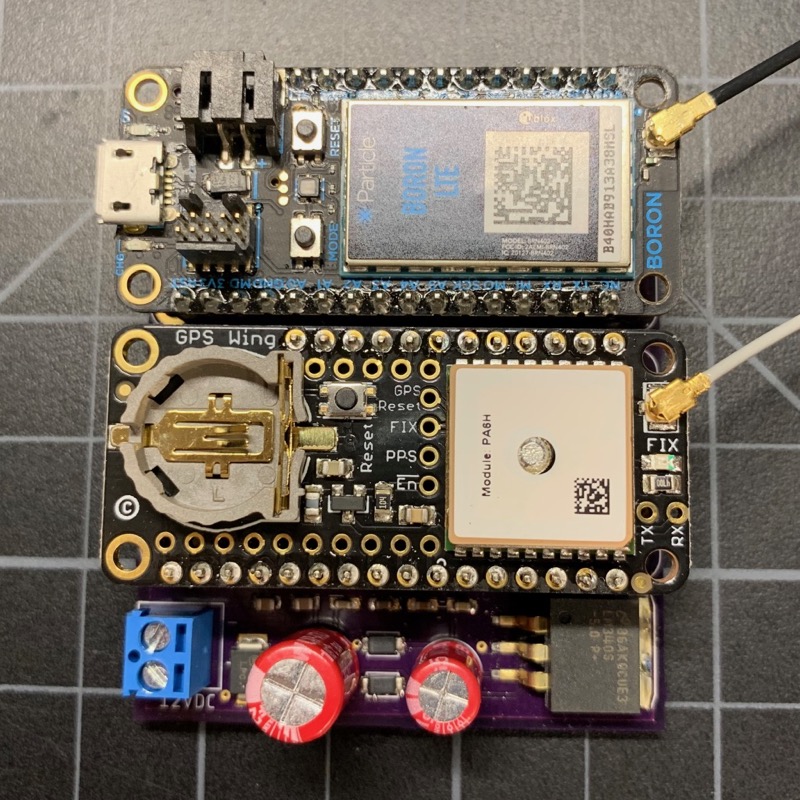Vehicle power
While the Electron, E-Series, and Boron have power supply inputs that will accept 12V, it's best to avoid connecting the VIN power input directly to a vehicle electrical system. There may be voltage spikes that exceed the absolute maximum limits of the device and cause damage.
There are many possible designs, but we like the OpenXC Platform designs. These were created by Ford and open-sourced specifically for using microcontrollers in vehicles.
The design includes a 5V output which can be used across all devices, including the Photon, P1, Argon, and Xenon as well as the Boron, E-Series, and Electron.
This shows the unregulated 12V (top), 5V regulated (middle), and 3V3 from a Boron (bottom):

You can download the files associated with this app note as a zip file.
Design 1
This design is almost exactly the OpenXC power supply design. It's built in an Adafruit Feather form-factor because it's useful for prototyping new designs and you can easily swap between cellular (Boron) and Wi-Fi (Argon). The design is easily extracted to make it part of your base board for an E-Series or B-Series SoM as well. Design 3 is an alternative way to lay out this design.
Schematic 1
This is the standard design schematic:

Of interest:
- A SZ1SMB16CAT3G TVS diode protects against large voltage transients.
- A RS1JFP is the reverse voltage protection diode.
- This version uses a LM340 linear regulator. It's rated for 1.2A.
- There are a number of capacitors to smooth out the power.
- Input components are rated for 35V.
This power supply can be used for:
- Any Wi-Fi based device.
- Any LTE cellular device (E-Series LTE, Boron LTE, B402 SoM).
- Any cellular device that also includes a Li-Po battery backup.
In other words, 2G/3G cellular devices need to have a Li-Po battery when use with the 1.2A power supply. Design 2 has a higher current rating and can be used without the Li-Po battery.
BOM 1
| Quantity | Part | Description | Example | Cost |
|---|---|---|---|---|
| 2 | C1, C2 | Cap Ceramic 0.47 uF 35V 0603 | TDK CGA3E1X7R1V474K080AC | $0.26 |
| 3 | C3, C4, C8 | Cap Ceramic 0.1 uF 35V 0603 | Taiyo Yuden GMK105BJ104KV-F | $0.12 |
| 1 | C5 | Cap Alum 270 uF 35V | Panasonic EEE-FK1V271SP | $0.84 |
| 1 | C6 | Cap Alum 150 uF 10V | Panasonic EEE-FK1A151P | $0.51 |
| 1 | C7 | Cap Ceramic 0.022 uF 50V 0603 | Kemet C0603C223K5RACTU | $0.10 |
| 1 | D1 | TVS Diode 26V Clamp 23.1A | Littelfuse SZ1SMB16CAT3G | $0.97 |
| 1 | D2 | Diode 1.2A | ON Semiconductor RS1JFP | $0.44 |
| 1 | U2 | Linear regulator 5V 1A TO263-3 | Texas Instruments LM340SX-5.0/NOPB | $1.58 |
| 1 | J2 | Term Block 2 Pos 3.5mm | On Shore OSTTE020161M | $0.67 |
| Male header pins 0.1" | Sullins PRPC040SAAN-RC |
Board 1


Design 2
Schematic 2

This version uses a Semtech TS30042 2A switching regulator. This is more efficient, and has sufficient power for any Particle device with or without a Li-Po battery.
If you are hand-assembling boards, the regulator in Design 1 is much easier to solder. The pads on the TS30042 are quite small and are blind on the bottom, making it harder to align.
BOM 2
| Quantity | Part | Description | Example | Cost |
|---|---|---|---|---|
| 2 | C1, C2 | Cap Ceramic 0.47 uF 35V 0603 | TDK CGA3E1X7R1V474K080AC | $0.26 |
| 1 | C3 | Cap Ceramic 0.1 uF 35V 0603 | Taiyo Yuden GMK105BJ104KV-F | $0.12 |
| 1 | C4 | Cap Ceramic 10 uF 35V 0805 | Murata GRM21BC8YA106ME11L | $0.43 |
| 1 | C5 | Cap Alum 270 uF 35V | Panasonic EEE-FK1V271SP | $0.84 |
| 1 | C6 | Cap Ceramic 0.022 uF 50V 0603 | Kemet C0603C223K5RACTU | $0.10 |
| 2 | C7, C7 | Cap Ceramic 22 uF 6.3V 0805 | Murata GRM219R61A226MEA0D | $0.42 |
| 1 | D1 | TVS Diode 26V Clamp 23.1A | Littelfuse SZ1SMB16CAT3G | $0.97 |
| 1 | D2 | Diode 2A | ON Semiconductor NRVHP220SFT3G | $0.43 |
| 1 | L1 | Inductor 4.7 uH 3A | Wurth 744774047 | $1.78 |
| 1 | U1 | Switching regulator 5V 2A | Semtech TS30042-M050QFNR | $1.64 |
| 1 | J2 | Term Block 2 Pos 3.5mm | On Shore OSTTE020161M | $0.67 |
| Male header pins 0.1" | Sullins PRPC040SAAN-RC |
Board 2


Design 3
This is design 1 (LM340 linear regulator), but with the components shifted around. It's a Feather Doubler that includes a power supply on the base board. You might use this with a Boron and an Adafruit Ultimate GPS, for example.
It also uses through-hole capacitors. There's really no advantage to doing it that way, but it is an option.
Schematic 3

BOM 3
| Quantity | Part | Description | Example | Cost |
|---|---|---|---|---|
| 2 | C4, C5 | Cap Ceramic 0.47 uF 35V 0603 | TDK CGA3E1X7R1V474K080AC | $0.26 |
| 3 | C6, C7, C10 | Cap Ceramic 0.1 uF 35V 0603 | Taiyo Yuden GMK105BJ104KV-F | $0.12 |
| 1 | C8 | Cap Alum 270 uF 25V | Wurth 860080474011 | $0.36 |
| 1 | C9 | Cap Ceramic 0.022 uF 50V 0603 | Kemet C0603C223K5RACTU | $0.10 |
| 1 | C11 | Cap Alum 150 uF 25V | Wurth 860020473010 | $0.16 |
| 1 | D1 | TVS Diode 26V Clamp 23.1A | Littelfuse SZ1SMB16CAT3G | $0.97 |
| 1 | D2 | Diode 1.2A | ON Semiconductor RS1JFP | $0.44 |
| 1 | U2 | Linear regulator 5V 1A TO263-3 | Texas Instruments LM340SX-5.0/NOPB | $1.58 |
| 1 | J2 | Term Block 2 Pos 3.5MM | On Shore OSTTE020161M | $0.67 |
| 2 | Header 12 pos 0.1" | Sullins PPTC121LFBN-RC | $0.78 | |
| 2 | Header 16 pos 0.1" | Sullins PPTC161LFBN-RC | $0.98 |
Board 3



